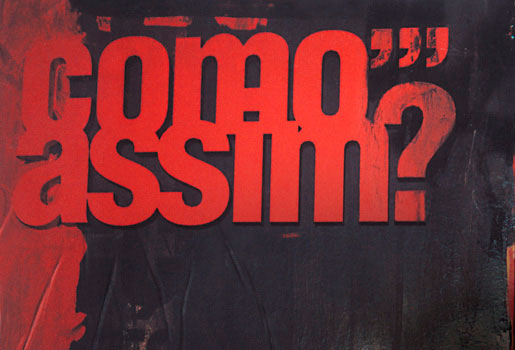Claudio Rocha, Typographer, Director and Vice President of the Oficina Tipográfica São Paulo [São Paulo Typographical Workshop] came to the Archive to research images for the Bienal Timeline, a project in partnership with the Oficina and Fundação Bienal made possible through collective funding through the site Catarse.

Rocha, who is now responsible for the Timeline project told us about his participation in the exhibition Rede de Tensão Bienal 50 anos, in 2001, as a member of the group Caminho Suave alongside Ferlauto, Marcos Mello, Herbert, Vitché, Nina and Os Gêmeos. According to Claudio’s own text the group’s work for the exhibition “sought out a new perspective for the citizen conditioned to see the city at a glance from behind a car window.”

General view of installation by Caminho Suave group in the catalogue for exhibition Rede de Tensão Bienal 50 anos (2001), p. 138
“The images, texts and objects exposed are part of urban life, such as graffiti, flyposters, and objects sold by stallholders, transcribed and recreated in an intricate space, built from scrap and wood paneling. Some very familiar elements of urban iconography, which quickly disappear or vanish in the excesses of big cities, could be seen in detail,”, affirms Rocha.
According to Rocha “…this installation brought anxiety, and even some of the absurd nonsense of visual communication found in the streets in a journey which forced the visitors to creep down alleys and squat down to reach the rooms where the work of the group members was shown. Superimposed layers, a mixture of mundane materials, irony and jokes created an awkwardness necessary for the viewer to be able to discover nuances impossible to be perceived at a distance and also to poke about in a space where the value of the message was not solely confined to its content. “

Herbert Baglione’s painting

Vitché’s painting

Os Gêmeos
For his new project with the Bienal, Claudio Rocha follows the mission of the Oficina Tipográfica in the development of another experimental design project in which language and technique walk hand in hand. The Timeline will tell the story of the Bienals in tandem with the design evolution of the last few decades, changing, according to the given time, in style, in typography..
A print edition also accompanies this evolution: the first years will be printed in typography, passing through 1970s and into offset printing and more recently digital printing. “As a language and science, typography evolved sensitively over the last few decades, in the world of art too”, concludes him.

